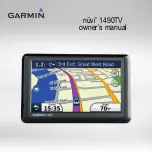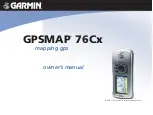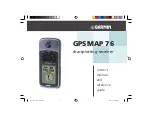
4
2.
General
Information
2.1
What
is
GPS?
The
GPS
(Global
Positioning
System)
satellite
system
was
originally
set
up
by
the
Ministry
of
Defense
of
the
United
States
of
America
in
order
to
improve
precise
control
for
military
purposes.
The
US
congress
granted
funds
at
that
time
for
setting
up
the
system,
however
only
on
the
condition
that
it
was
also
made
available
for
free
civilian
use.
GPS
satellites
send
two
divergent
signals:
an
encoded,
very
precise
signal
for
NATO
(P)
and
an
unencrypted
signal
for
civilian
purposes,
i.e.
for
everyone
(L1).
Your
GPS
receiver
can
receive
the
unencrypted
signal
for
civilian
purposes
(L1).
The
civilian
signal
can
be
used
by
means
of
GPS
receivers
by
anyone,
at
any
time,
world
‐
wide
and
license
free
e.g.
for
vehicle
navigation.
Also
the
GPS
satellite
system
in
Europe
is
operated
by
the
Government
of
the
United
States
of
America
which
also
has
exclusive
responsibility
for
the
accuracy
and
maintenance
of
the
system.
The
system
is
constantly
improved
and
modifications
can
consequently
influence
the
accuracy
and
the
performance
of
the
GPS
receiver.
Achievable
accuracy
for
the
civilian
signal
is
currently
about
10
meters.
Before
2
nd
May
2000
this
signal
was
intentionally
falsified
by
the
USA
(SA,
Selective
Availability)
and
achievable
accuracy
was
100
m
at
that
time.
"Selective
Availability"
or
SA
is
the
artificial
degradation
of
the
satellite
signal
by
the
US
military.
The
signal
can
currently
still
be
artificially
falsified
in
emergencies.
This
can
lead
to
substantial
impairments
with
the
use
of
your
GPS
receiver
and
make
it
unusable,
at
least
temporarily,
for
certain
applications,
e.g.
navigation.
SatGuide
has
no
influence
on
this.
There
are
about
30
satellites
(24
satellites
plus
correction
and
reserve
satellites)
on
six
paths
in
circulation,
of
which
up
to
12
can
be
present
over
the
horizon.
Your
GPS
receiver
has
20
channels
and
can
therefore
receive
signals
from
all
12
satellites
at
the
same
time,
as
long
as
it
is
in
visual
contact
with
them,
resulting
in
optimized
calculation
of
the
GPS
receiver's
position.
Whenever
your
GPS
receiver
has
access
to
a
clear
sky,
it
can
determine
its
position,
direction
and
speed
within
a
short
period
of
time.
Thick
clouds
and
heavy
rainfall
can
impair
GPS
reception.
The
time
it
takes
to
establish
initial
contact
to
the
satellites
(Time
‐
to
‐
First
‐
Fix,
TTFF)
is
reduced
considerably
by
an
assisted
GPS
functionality
in
SatGuide
and
can
take
few
seconds
when
the
assisted
functionality
is
available
and
access
to
clear
sky
is
unobstructed
or
several
minutes
when
conditions
are
not
optimal.
Summary of Contents for BT? GPS?8
Page 1: ...1 ...




































